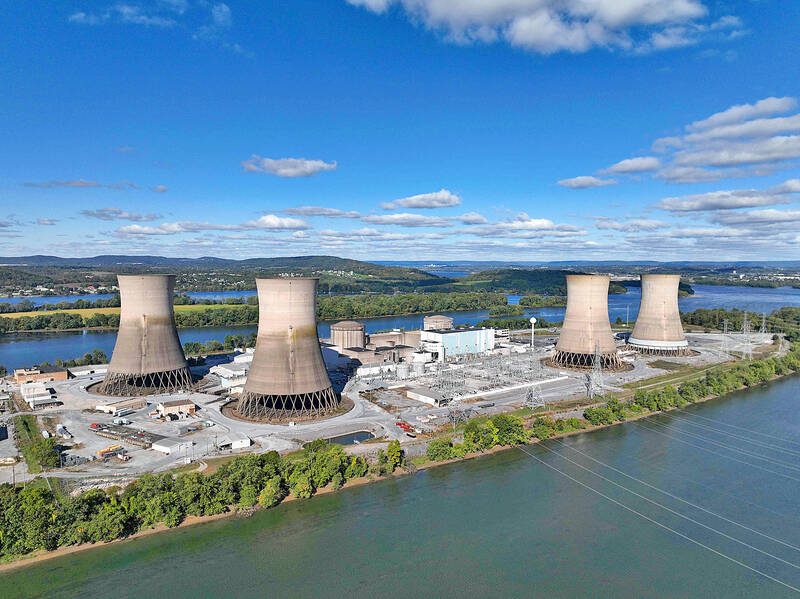NextEra Energy Inc, one of the world’s biggest suppliers of wind and solar power, is seeking to expand its natural gas and nuclear generation in a bid to meet the surging demand for electricity sparked by artificial intelligence (AI).
The company has partnered with gas turbine manufacturer GE Vernova Inc to build power generation for data centers and factories, chief executive officer John Ketchum said on an earnings call on Friday.
NextEra has also taken the first step to restarting its shuttered Duane Arnold nuclear plant in Iowa.

Photo: AFP
US power consumption is rising, driven by data centers and AI, along with manufacturing and the increasing electrification of the economy. That has spurred demand for new gas plants and reawakened interest in nuclear energy. The electricity boom has sparked new ideas and deals that would once have been unthinkable.
“The idea would be to go after and target large-load customers and do it in an integrated way where we can combine gas-fired generation with renewable and battery storage,” Ketchum said on an earnings call on Friday.
NextEra shares gained as much as 5.8 percent in New York.
“It can’t be underestimated how much this industry has changed in a very short amount of time, really the last 15 months to 18 months,” Rebecca Kujawa, head of subsidiary NextEra Energy Resources, said on the call. “We’ve seen a lot of increase in demand for natural gas.”
GE Vernova has said data centers favor gas over intermittent renewable sources like wind because the facilities demand power around the clock. GE Vernova chief executive officer Scott Strazik this week said that orders for gas turbines more than doubled to 20 gigawatts last year and he expects this year to be even stronger.
NextEra has asked US regulators for a licensing change for the Duane Arnold nuclear plant, a first step toward potentially restarting the Iowa facility.
NextEra aims to get the reactor up and running again as early as the end of 2028, it said on Friday in an earnings release. The request was filed with the US Nuclear Regulatory Commission on Thursday, a company representative said. NextEra had previously said it was interested in reviving the plant.
NextEra is not the only company pursuing efforts to revive reactors. South Carolina utility Santee Cooper on Wednesday said it is seeking bids to restart construction of two reactors at the VC Summer Nuclear Station near Jenkinsville in South Carolina.
In September last year, NextEra rival Constellation Energy Corp announced plans to restart a reactor at the Three Mile Island plant in Pennsylvania to supply Microsoft Corp.
The 600-megawatt Duane Arnold plant closed in 2020 after its biggest customer decided to exit its power-purchase agreement. The facility was also damaged in a windstorm that same year, prompting the company to close the plant two months earlier than planned.
NextEra has said Duane Arnold, which went into service in 1974, uses less-complex technology that might make it easier to revive than newer nuclear plants.
However, Jefferies & Co analyst Julian Dumoulin-Smith has said bringing the facility back into service would be costly and there is no guarantee the economics would be justified.

Taiwan Semiconductor Manufacturing Co (TSMC, 台積電) would not produce its most advanced technologies in the US next year, Minister of Economic Affairs J.W. Kuo (郭智輝) said yesterday. Kuo made the comment during an appearance at the legislature, hours after the chipmaker announced that it would invest an additional US$100 billion to expand its manufacturing operations in the US. Asked by Taiwan People’s Party Legislator-at-large Chang Chi-kai (張啟楷) if TSMC would allow its most advanced technologies, the yet-to-be-released 2-nanometer and 1.6-nanometer processes, to go to the US in the near term, Kuo denied it. TSMC recently opened its first US factory, which produces 4-nanometer

GREAT SUCCESS: Republican Senator Todd Young expressed surprise at Trump’s comments and said he expects the administration to keep the program running US lawmakers who helped secure billions of dollars in subsidies for domestic semiconductor manufacturing rejected US President Donald Trump’s call to revoke the 2022 CHIPS and Science Act, signaling that any repeal effort in the US Congress would fall short. US Senate Minority Leader Chuck Schumer, who negotiated the law, on Wednesday said that Trump’s demand would fail, while a top Republican proponent, US Senator Todd Young, expressed surprise at the president’s comments and said he expects the administration to keep the program running. The CHIPS Act is “essential for America leading the world in tech, leading the world in AI [artificial

REACTIONS: While most analysts were positive about TSMC’s investment, one said the US expansion could disrupt the company’s supply-demand balance Taiwan Semiconductor Manufacturing Co’s (TSMC, 台積電) new US$100 billion investment in the US would exert a positive effect on the chipmaker’s revenue in the medium term on the back of booming artificial intelligence (AI) chip demand from US chip designers, an International Data Corp (IDC) analyst said yesterday. “This is good for TSMC in terms of business expansion, as its major clients for advanced chips are US chip designers,” IDC senior semiconductor research manager Galen Zeng (曾冠瑋) said by telephone yesterday. “Besides, those US companies all consider supply chain resilience a business imperative,” Zeng said. That meant local supply would

Servers that might contain artificial intelligence (AI)-powering Nvidia Corp chips shipped from the US to Singapore ended up in Malaysia, but their actual final destination remains a mystery, Singaporean Minister for Home Affairs and Law K Shanmugam said yesterday. The US is cracking down on exports of advanced semiconductors to China, seeking to retain a competitive edge over the technology. However, Bloomberg News reported in late January that US officials were probing whether Chinese AI firm DeepSeek (深度求索) bought advanced Nvidia semiconductors through third parties in Singapore, skirting Washington’s restrictions. Shanmugam said the route of the chips emerged in the course of an